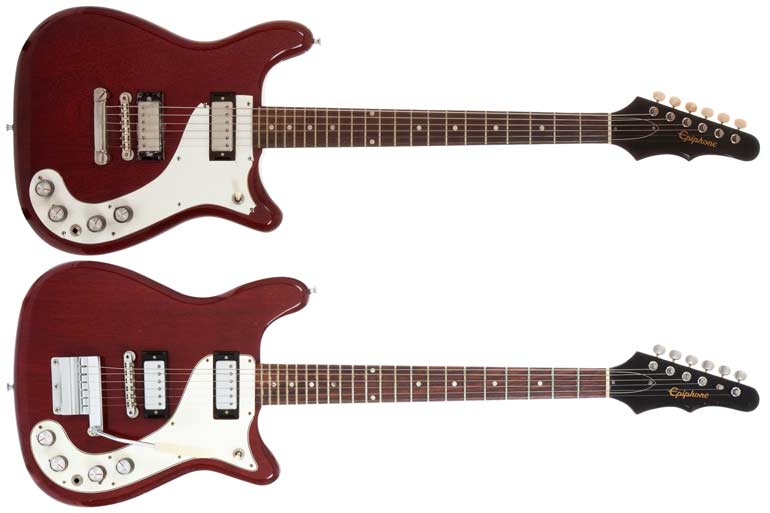
The Epiphone solid body guitar range was launched in 1959, with the Coronet and Crestwood models - with the Wilshire added a year later in 1960. All guitars were built at Gibson's Kalamazoo plant in Michigan, USA, side-by-side with many Gibson solid body models. Like 1960s Gibsons, vintage Epiphone Wilshire guitars are great playing, highly collectable instruments. They are lightweight with great fret access, well-built, and quite unique in design - no wonder they are so desirable.
The Epiphone solid-body range could be directly correlated to the Gibson SG range sharing many features; hardware, pickup configurations, body and neck woods, construction and controls. They were all made at Gibson's Kalamazoo factory, so this is not surprising. The Wilshire (particularly the early P90 model) corresponds to Gibson's SG Special. Both had a mahogany neck and body with a 22 fret rosewood fretboard, a 24 3/4" scale length, a translucent cherry finish, two pickups, each with a volume and tone control, and a pickup selector switch.
Across nine years of production, a total of 2640 Epiphone Wilshire were shipped. This total includes 183 12-string Epiphone Wilshire. 1964 was the peak year, with 1045 guitars shipped. See shipping stats.
Other than the Olympic Special, all 1960s Epiphone solid body guitars and basses had the same body style (almost symmetrical pre-1964, with a shortened lower horn thereafter), they are the Epiphone Crestwood Custom, Epiphone Olympic and Epiphone Coronet guitars, and the Epiphone Newport and Epiphone Embassy Deluxe basses.
Headstocks were initially the same style as the pre-Gibson Epiphone models, i.e. two sided, and not that different to the Gibson headstock profile. Perhaps this was the reason that in the second half of 1963, Epiphone solid body headstocks were redesigned with a single-sided batwing design.

Two versions of the Epiphone Wilshire from 1963: the SB432 (with stop tailpiece) and the SB432V (with Maestro Vibrola)Image Heritage auctions

A twelve-string version, the Wilshire-12 or SB432-12 was launched in 1966 - with no vibrato and a double sided headstock, 6 tuners per side. A total of 183 were shipped between 1966 and 1968.
The Wilshire was one of the guitars Jimi Hendrix used in the early 1960s, when playing with Don Covay and Little Richard. As usual, Hendrix used a right handed guitar, flipped upside down. Left handed Epiphone solid bodies were not listed as available, and if any were produced, they were certainly not widely available. It seems the only lefty Epiphones manufactured in the 1960s were those that used existing tooling from the pre-aquistion models, or the same tooling as Gibson equivalents, e.g. the Epiphone Casino (which had the same body as the ES-330). With it's perfectly symmetrical body, and deep double cutaways, the Wilshire was the perfect guitar for flipping around and playing left handed.
1961 'guitars, basses, amplifiers' catalogue
“A truly sensational solid body guitar with features that win it top rating from professionals who appreciate its tonal range, instant response and easy action for professional performance”
1962 'guitars, basses, amplifiers' catalogue
“Handsome Honduras mahogany body in a modern contoured design... all 22 frets above the cutaway”
1964 full line catalogue
This is the first catalogue to show the new-style asymmetrical Wilshire, with six-a-side tuners
1966 full line catalogue
“Epiphone is proud to present solid body instruments that offer the depth, the sharp treble, the biting tone and the virility that all guitarists seek from a solid body instrument”
Epiphone shipping statistics have to be read with caution: although total numbers are broadly accurate, the data for the different variants of this guitar can not be regarded as absolute: in some years guitars were lumped together, others separated out. For example, between 1960 and 1965, the basic SB432 model was without vibrato, though between '66 and '69 all Wilshires had a Maestro vibrato, so even though models SB432 V and SB432 MV are not listed, all had vibratos. Furthermore all Epiphone publicity from 1962 list the Maestro vibrato as optional, yet some were certainly shipped with the Epiphone Tremotone version. It would seem that many of the SB 432 V guitars were actually shipped with the Maestro rather than Tremotone. The model listed as SB432 RF is in 'Red Fox' finish. Interestingly this finish was first listed in the 1963 Epiphone price list, and last listed in 1965 - yet shipping figures only list this finish separately for 1967. As no other finishes options are listed (and the Wilshire was available in other custom finishes), it can only be assumed that prior to this date Red Fox finishes were included in the SB432 and SB432 V totals. An inference that only 16 guitars were shipped in Red Fox, or 1965 was the only year that the Maestro vibrato was fitted would be incorrect.
| 1960 | 1961 | 1962 | 1963 | 1964 | 1965 | 1966 | 1967 | 1968 | 1969 | total | |
| SB432 | 59 | 186 | 180 | 92 | 246 | 129 | 398 | 123 | 44 | 18 | 1475 |
| SB432 V | 24 | 42 | 101 | 305 | 472 | ||||||
| SB432 MV | 494 | 494 | |||||||||
| SB432 12 | 135 | 43 | 5 | 183 | |||||||
| SB432 RF | 16 | 16 |
$2500
$860
$996
$4500
$799
$790
€2795
£8499
£2259
C $1050
£823
£2259